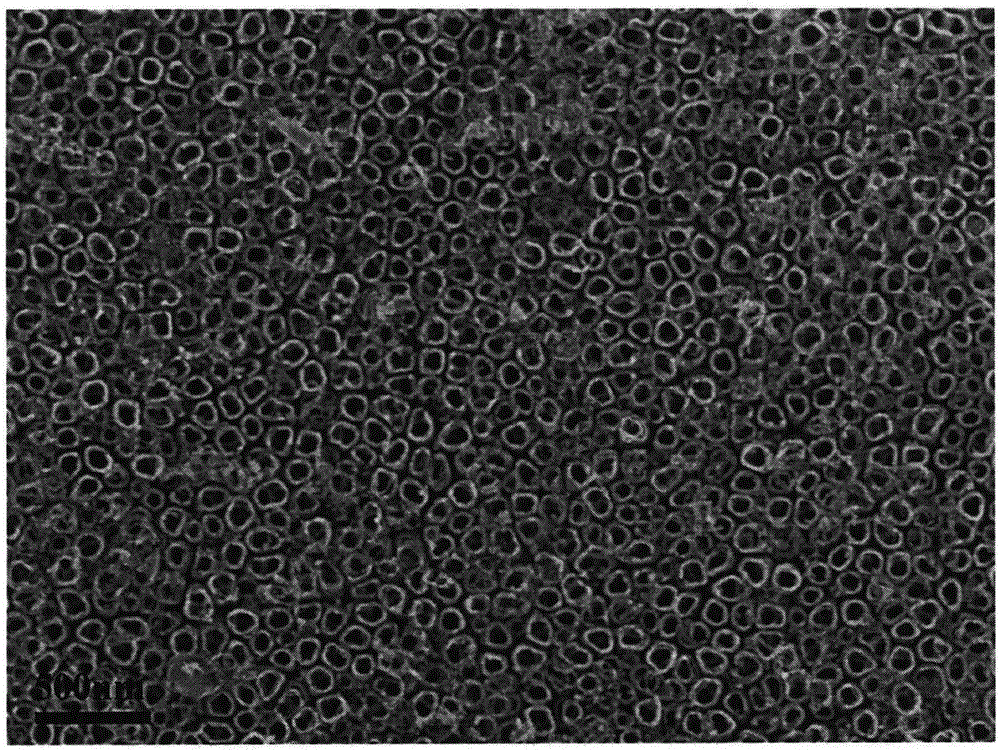Method for in-situ preparation of graphite-like-phase carbon nitride quantum dot/titanium dioxide nanotube array visible-light-induced photocatalyst
A graphitic carbon nitride and nanotube array technology, which is applied in physical/chemical process catalysts, chemical instruments and methods, chemical/physical processes, etc., can solve the problems of time-consuming and energy-consuming, complex preparation methods, etc., and save energy. Energy, simple preparation, and the effect of improving the catalytic performance of visible light
- Summary
- Abstract
- Description
- Claims
- Application Information
AI Technical Summary
Problems solved by technology
Method used
Image
Examples
Embodiment 2
[0031] 1) Take a 2.0cm×5.0cm pure titanium sheet (purity ≥ 99.0%), dip it in a mixed acid solution of 10ml hydrofluoric acid, 40ml nitric acid, and 50ml water for 5min, then take it out and rinse it with deionized water; Put it into acetone, isopropanol, methanol, ethanol, and water for ultrasonic cleaning for 15 minutes, and finally take it out and dry it for later use;
[0032] 2) Take 200ml of water, 200ml of glycerin, and 4.0g of ammonium fluoride to prepare an electrolyte; take 0.1g of melamine and add it to the electrolyte, and stir for 5 minutes to fully mix;
[0033] 3) The cleaned titanium sheet is used as the anode, the platinum wire is used as the cathode, and the distance between the two electrodes is 2.0cm, and the voltage is boosted from zero to 20V at a rate of 250mV / s, and kept at 20V for 2h to perform anodic oxidation;
[0034] 4) After anodizing, take out the titanium sheet and rinse it with deionized water to remove excess electrolyte, put it in a muffle fur...
Embodiment 3
[0036] 1) Take a 2.0cm×5.0cm pure titanium sheet (purity ≥ 99.0%), dip it in a mixed acid solution of 10ml hydrofluoric acid, 40ml nitric acid, and 50ml water for 5min, then take it out and rinse it with deionized water; Put it into acetone, isopropanol, methanol, ethanol, and water for ultrasonic cleaning for 15 minutes, and finally take it out and dry it for later use;
[0037]2) Weigh 5g of melamine powder, place it in a capped alumina crucible, keep it warm for 2 hours at 520 degrees Celsius, take it out and grind it to obtain graphite-like carbon nitride;
[0038] 3) Take 200ml of water, 200ml of glycerin, and 4.0g of ammonium fluoride to prepare an electrolyte; take 0.1g of graphite-like carbon nitride powder and add it to the electrolyte, and stir for 5 minutes to fully mix;
[0039] 4) The cleaned titanium sheet is used as the anode, the platinum wire is used as the cathode, the distance between the two electrodes is 2.0cm, and the anodic oxidation process is carried o...
PUM
| Property | Measurement | Unit |
|---|---|---|
| diameter | aaaaa | aaaaa |
Abstract
Description
Claims
Application Information
 Login to View More
Login to View More - R&D
- Intellectual Property
- Life Sciences
- Materials
- Tech Scout
- Unparalleled Data Quality
- Higher Quality Content
- 60% Fewer Hallucinations
Browse by: Latest US Patents, China's latest patents, Technical Efficacy Thesaurus, Application Domain, Technology Topic, Popular Technical Reports.
© 2025 PatSnap. All rights reserved.Legal|Privacy policy|Modern Slavery Act Transparency Statement|Sitemap|About US| Contact US: help@patsnap.com



